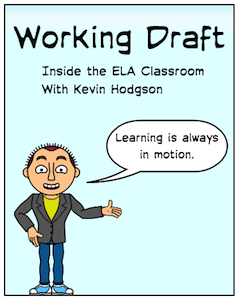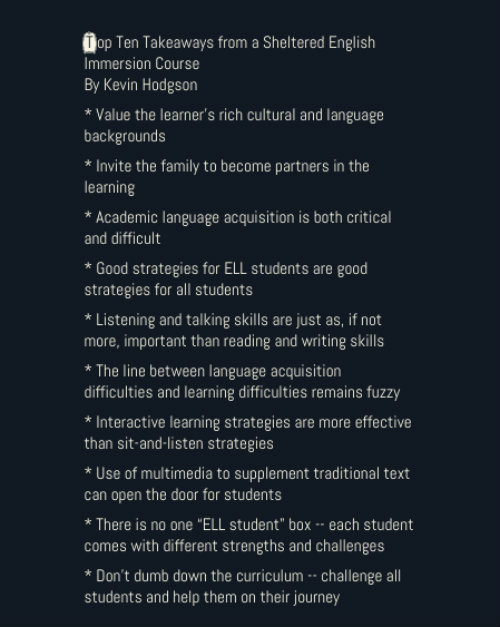Lessons Learned During ELL Immersion
A MiddleWeb Blog
 Talk about immersion. In our state, every teacher and every school administrator is now being required to take an English Language Sheltered Immersion course for re-certification, and the mad scramble to get spots in the few courses being offered by the state Department of Elementary and Secondary Education has been fierce.
Talk about immersion. In our state, every teacher and every school administrator is now being required to take an English Language Sheltered Immersion course for re-certification, and the mad scramble to get spots in the few courses being offered by the state Department of Elementary and Secondary Education has been fierce.
I was able to get into a course this past fall, along with a handful of colleagues from my school, including the entire sixth grade teaching team. Every Wednesday night, for four months, we dove into strategies to meet the needs of English Language Learners. (Our state is doing this because of pressure from the federal Department of Justice, based on the stagnant data of ELL students in our state, apparently.)
I could do a whole column on frustrating course design and materials of the immersion class, but I won’t, except to say that a course to help struggling learners should have been better organized than it was, particularly if it was designed to be a model for teachers.
Luckily for us, we had a stellar instructor, a classroom teacher who knew her stuff and who supplemented the canned state-mandated curriculum with pertinent information and resources.
Despite those frustrations, and despite the heavy workload (we were expected to learn new strategies one week, implement these strategies in our classrooms with ELL students within days, write a full report on the implementation, and then return the next week to start the cycle all over again), I learned quite a bit about how to best meet the needs ELL students, particularly in content-area vocabulary instruction.
Here, then, are my Top Lessons Learned ….






























Thank you for sharing! I ran across “sheltered English Immersion” in my masters in ELL program, but I couldn’t find out exactly what it is. I am familiar with English immersion, and Sheltered Instruction, but not the combination of the two. Can you tell me more?
I’m surprised you only ran into sheltered English immersion briefly in your MA program. All it is is a combination of the 2: sheltered instruction and English immersion. BTW, Kevin, this is really interesting list of learned information! Thanks for sharing.
Canada is leading the way in ELL teacher training. I hypothesize that Canadian diversity has had a less bumpy road than the US has had, the ‘new’ were often more welcome there than here. Ah well, another conversation as well as an intersect with one of Kevin’s lessons learned – appreciate students home cultures, sometimes called cultural intelligence.
Here is a helpful site for a general intro to flipping classrooms, that can yield a very efficient inclusion of multimedia resources AND stronger use of seat time for listening and talking. Two of his other lessons learned.
https://www.insidehighered.com/blogs/gradhacker/flipping-out-what-you-need-know-about-flipped-classroom
Side note check out: http://www.myenglishonline.ca/for-teachers/
The regular professional development section from English On Line is open to other than Canadian teachers. Thanks to Canadian generosity. Realize was excellent this year. You can listen to 2014 and 2015 key note and sections archived there somewhere.
Kevin, nice use of PNG or something. Great presentation. In my opinion demonstrating audio, including YOU introducing your piece and you would have a perfect example of a flipped classroom, tool!!! Put it out on the dedicated youtube section. http://vidstatsx.com/youtube-top-100-most-subscribed-education-channels
I have an idea of the text book your course used. ☺
Thanks for comments, everyone.
Kevin
Thank you for the slide presentation, I shared it with colleagues!